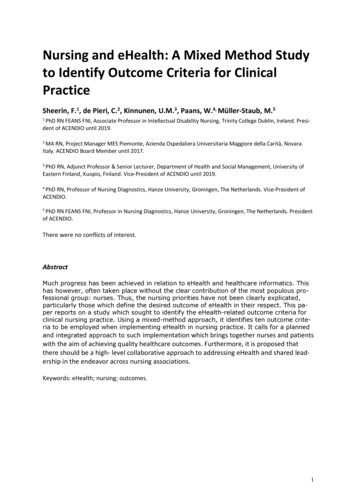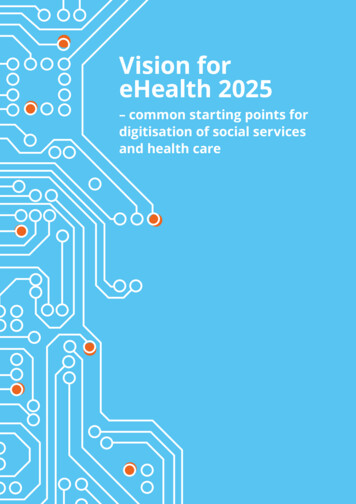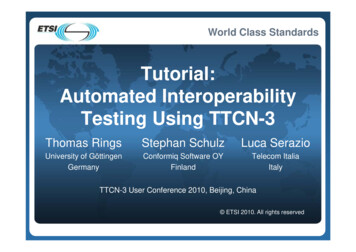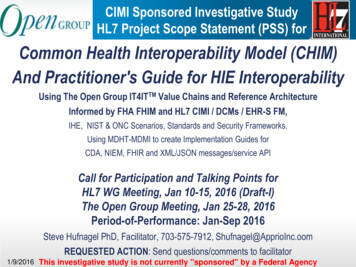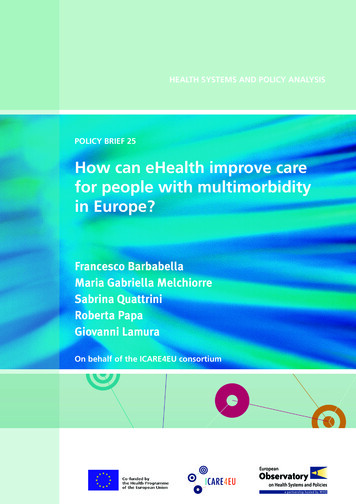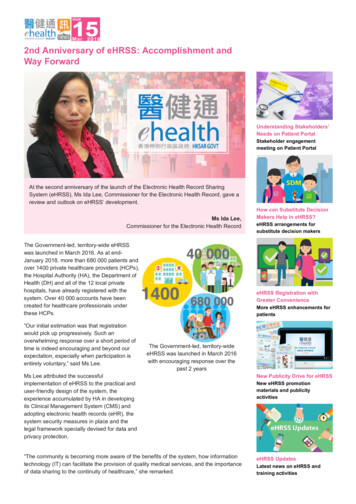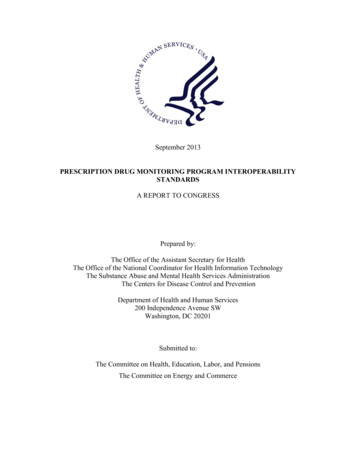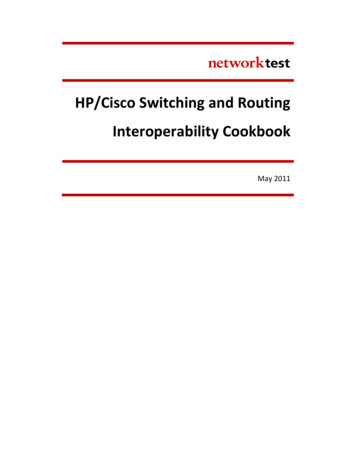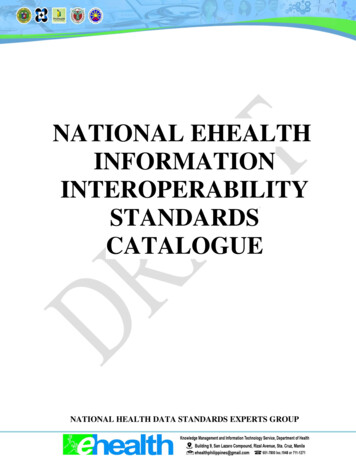
Transcription
NATIONAL UENATIONAL HEALTH DATA STANDARDS EXPERTS GROUP
DOCUMENT VERSION CONTROL LOGVersionControl #1.0DescriptionDateRemarksInitial Release31 August 2015JUMG1.1UpdatedNovember 2015JUMG1.2.Inserted Remark section.14 December 2015JUMG1.3.Created separated listings forMandatory Health Standards forImplementation, and Health DataStandards for Consideration, whichare ongoing technical review.01 August 2016JUMG
OPERATIONAL DEFINITIONS1Data2Data/Information Artifacts3Department of Health (DOH)4eHealth5Health Data Standard/s6Information7Information Interoperability8Interoperability9National eHealth nal eHealth InformationInteroperabilityStandardsChange Management Manual1011National eHealth SteeringCommittee (NeHSC)12National eHealth TechnicalWorking Group (TWG)13NationalHealthDataStandards Experts GroupInformation in raw or unorganized form that refers to, or represents conditions,ideas, or objects.Tangible by-products of data or information objects produced during thedevelopment, adoption, or implementation of national health data standards.The government agency mandated as the overall technical authority on health thatprovides national policy direction and develops national plans, technical standardsand guidelines on health. It is also a regulator of all health services and products,and provider of special or tertiary health care services and of technical assistanceto other health providers especially to local government units.World Health Organization defined eHealth as “the use of information andcommunication technologies (ICT) for health.”Codes used for encoding data elements such as drug/medicine codes or medicalprocedure codes. It can also refer to eHealth information interoperabilitystandards, standard codes, standard code set, or standards.Data that has been given value through analysis, interpretation, or compilation inany meaningful form.The ability to transfer and use information in a uniform and effective manneracross multiple organizations and information technology systems. This aspect ofinteroperability ensures that organizations share a common understanding andmeaning for information that is shared across different IT systems.The ability to which systems and devices can exchange data and interpret thatshared data.Contains all approved eHealth information interoperability standard codes formandatory adoption and implementation in all electronic health transaction. It canalso refer to the eHealth Standards Catalogue.Provides the operational and management guidelines for establishing, adopting,implementing, and monitoring the eHealth information interoperability standardsfor all electronic health transactions across all local and national healthinformation systems and applications. It can also refer to the eHealth StandardsChange Management Protocol (eHSCMP).The overarching eHealth committee to oversee and set direction in the continuousdevelopment and/or improvement, adoption, operational maintenance, andmonitoring of the common and mandatory eHealth information interoperabilitystandards.The intermediary strategy team of the National eHealth Steering Committee in theadoption, operational maintenance, and monitoring of the common and mandatoryeHealth information interoperability standards.The eHealth experts group created by the NeHSC and the TWG to spearhead andprovide direction and tactical input in the adoption, implementation, monitoringand evaluation of the common and mandatory eHealth informationinteroperability standards.
I. INTRODUCTIONCritical elements were identified to achieve the intended objectives of the national eHealth vision. Among these isthe adoption and implementation of eHealth information interoperability standards. In the absence of a formalreference register of health data standards, the National Health Data Standards Experts Group arrived at aconsensus to develop a national reference directory of all standard codes through the development andimplementation of the National eHealth Information Interoperability Standards Catalogue (eHealth StandardsCatalogue).The eHealth Standards Catalogue is envisioned to contain all eHealth information interoperability standard codesfor implementation in all electronic health transactions, in support to the attainment of seamless informationalinteroperability at all governance and management levels of health data and information. The eHealth StandardsCatalogue is intended to provide the health data standards and the specific reference codes for all local andnational health information systems and applications, that would allow for integrated sharing and better exchangeof electronic health data record across various health facilities, health information organizations, and governmentagencies without loss of semantics; thereby, leading to better healthcare delivery response, and improved healthdecision making.II. OBJECTIVESThe National eHealth Information Interoperability Standards Catalogue aims to:1. Establish the core set of mandatory health data standards for informational interoperability across disparatehealth information systems and applications, and within the Philippine Health Information Exchange;2. Provide the standard reference codes for use in software and applications development; and3. Facilitate and promote the adoption of quality health data standards across all national healthcare informationnetworks.III. AUDIENCEThe eHealth Standards Catalogue is principally intended for all health facilities, government agencies and localgovernment units(LGUs), and stakeholder organizations (academe, research partners, purchasers of healthcare,producers, distributors, financial services, sellers, and donors) that serve as providers and/or users of electronichealth information and health services information. Health facilities include those at the primary, secondary, andtertiary level of community and hospital care, both in the public and private sectors.IV. SCOPE OF DEVELOPMENT AND IMPLEMENTATIONThe National eHealth Information Interoperability Standards Change Management Protocol provides theoperational and management guidelines for updating the contents of the eHealth Standards Catalogue by theNational Health Data Standards Experts Group under the auspices of the National eHealth Technical WorkingGroup and the National eHealth Steering Committee. The health data standards and their specific reference codescontained in the eHealth Standards Catalogue have already undergone sub-national implementation and areconsequently, deemed suitable for recommendatory and eventual mandatory national implementation on allelectronic health transactions across all local and national health information systems and applications.Constant work will be done to improve the eHealth Standards Catalogue’s contents as a result of continuousimprovements and new versions of existing standards being released, emerging international and local standardsbeing developed and launched, changing national eHealth climate and strategic context, and stakeholders’ needsand commitments. This reflects the reality that the national eHealth information interoperability standards need tobe constantly monitored for continuous necessity, relevance, organizational impact, level of implementationefforts and compliance at the various points of service.
V. MANDATORY HEALTH DATA STANDARDS#1STANDARD CODE SETVERSIONClinicalCurrentProcedural CPT dHealth The International Statistical ClassificationOrganizationof Diseases and Related Health Problems(WHO)10th Revision (ICD-10) is a coding ofdiseases, signs and symptoms, abnormalDepartmentof findings, complaints, social circumstancesHealth– and external causes of injury or diseases,Epidemiologyas classified by the World HealthBureauOrganization (WHO). The code set allowsmore than 14,400 different codes andpermits the tracking of many newdiagnoses. (Administrative Order 20130025)3Drug Classification Anatomical Therapeutic ATCand DosingandChemical 2015ClassificationSystem(ATC)/DefinedDailyDose (DDD)International Statistical ICD 10 v.Classificationand 2013Related Health Problems10th Revision (ICD 10)PhilippineWith Philippine ICD-10 ICD-10ModificationsModifications2ndedition:May 2014DDD WHOCollaboratingCentre for DrugStatisticsMethodology/NorwegianInstitute of PublicHealthDESCRIPTIONThe Current Procedural Terminology(CPT) describes medical, surgical, anddiagnostic services and is designed tocommunicate uniform information aboutmedical services and procedures amongphysicians, coders, patients, ive, financial, and analyticalpurposes. (Administrative Order 20130025)TheAnatomicalTherapeuticandChemical Classification System (ATC)divides drugs into different groupsaccording to the organ or system onwhichtheyactand/ortheir therapeutic and chemicalcharacteristics.The Defined Daily Dose (DDD) is theassumed average maintenance dose perREMARKSICD -10 is commonlyused for: Statistical reporting onmajor diagnoses andhealth problems; Mortality and morbiditystatistics; and Billing, reimbursementand resource allocation.
day for a drug used for its main indicationin adults. It is used to standardize thecomparison of drug usage betweendifferent drugs or between different healthcare environments. (Administrative Order2013-0025)4Laboratory Results LogicalObservations LOINC 2.36andClinical Identifiers Names andObservationsCodes (LOINC 2.36)RegenstriefInstitute, Inc.Logical Observation Identifiers Namesand Codes (LOINC) is a database anduniversal standard for identifying medicallaboratory observations. LOINC appliesuniversal code names and identifiersto medicalterminology relatedto electronic health records. The purposeis to assist in the electronic exchange andgathering of clinical results (such aslaboratory tests, clinical observations,outcomes management and research).(Administrative Order 2013-0025)5Medical igital Imaging and Communications inMedicine (DICOM) is a standard forhandling,storing,printingandtransmitting information in medicalimaging. It includes a file formatdefinition and a network communicationsprotocol; and enables the integration ofscanners, servers, workstation, printersand network hardware from multiplemanufacturers into a picture archiving andcommunication system. (AdministrativeOrder 2013-0025)6Geographic Areas PhilippineStandard 2015 PSGCof the PhilippinesGeographic Code 2015(PSGC)Digital Imaging and DICOM tisticsAuthorityNationalStatisticalThe Philippine Standard Geographic Codeis a systematic classification and coding– of geographic areas in the Philippines.Specifically, it is used for planning,surveys,census,voting,centers,
ormation systems and mapping.(Administrative Order 2013-0025)7Map CoordinatesWorld Geodetic System WGS 84 2004 UnitedStates The World Geodetic System is a reference(WGS 84)revisionDepartmentof coordinate system used by the GlobalDefensePositioning System for cartography andnavigation. It provides a standardcoordinate frame for the Earth, standardsmeasure for altitude, and surfacereference to define the nominal sea level.(Administrative Order 2013-0025)8Client IdentifierPhilippineHealth PhilHealth ID PhilHealthInsuranceCorporation Number(PhilHealth)Identification Number9HealthCare Professional Regulation PRC Registry ProfessionalProvider Identifier Commission(PRC) nalsRegistry:National Database ofHuman Resources forHealthInformationSystem (NDHRHIS)Registry:DepartmentofHealth – HealthHuman ResourceDevelopmentBureauThe PhilHealth Identification Number(PIN) is a unique and permanent numberissuedtoanyclientuponenrolment/membership registration to theNational Health Insurance Program of theCorporation for purposes of identification,eligibility verification, and utilizationrecording. (Administrative Order 20130025)The PRC license number that uniquelyidentifies all licensed healthcare providerssuch as doctors, nurses, ns.The NDHRHIS contains the list of basicaggregated demographic informationaboutselectedhumanresourceprofessionals – doctor, nurse, midwife,dentist, pharmacist, nutritionist-dietitian,medical technologist, physical therapist,andoccupationaltherapist.(Administrative Order No. 2015-0017)
10 Licensed Massage Official List of Licensed OfficialTherapists (LMT) MassageTherapists 2015in the Philippines(LMT) in the PhilippinesList DepartmentofHealth – HealthHuman ResourceDevelopmentBureauThe official master list of duly licensedmassage therapists in the Philippines. Theregistry contains the list of basicdemographic and registration informationof duly licensed massage therapists in thecountry.CommitteeofExaminersforMassage Therapy(CEMT)11 LicensedOfficial List of Licensed OfficialEmbalmers in the Embalmersinthe 2016PhilippinesPhilippines12 HealthIdentifierFacility National Health Facility NHFR v. 2Registry (NHFR)List DepartmentofHealth – HealthHuman ResourceDevelopmentBureauThe official master list of duly licensedembalmers in the Philippines. The registrycontains the list of basic demographic andregistration information of duly licensedembalmers in the country.Departmentof The National Health Facility RegistryHealth– (NHFR) is the official master list ofKnowledgehealth facilities for the Philippines. ThisManagement and ls and the public with a coreTechnologyset of information regarding healthServicefacilities in the country.Among these health facilities arehospitals, rural health units, barangayhealth stations, drug testing laboratories,drug abuse treatment and rehabilitationcenters, kidney transplant units, newbornscreening facilities, psychiatric carefacilities, ambulatory surgical clinics,bloodservicefacilities,dentallaboratories, dialysis clinics, HIV testinglaboratories, free standing clinics andother facilities licensed/accredited by theHealth Facilities and Services RegulatoryBureau of DOH.
13 DrugEstablishmentIdentifierDOHDrug DrugEstablishment Identifier EstablishmentModule v. 3 ofthe EDPMS ofDOHDepartmentofHealth – FoodandDrugAdministrationNational identifier code, taken from theDrug Establishment Identifier Module ofthe EDPMS, which uniquely identifiesand/or classifies drug establishmentslicensed/accredited by the Food and DrugAdministration of DOH. (AdministrativeOrder 2014-0034)14 RegisteredDrugs/Medicinesin the PhilippinesDOHDrug/Medicine Drug CodingIdentifierModule v. 3 entofHealth – FoodandDrugAdministrationNational identifier code, taken from theDrug Coding Module of the ElectronicDrug Price Monitoring System (EDPMS),which uniquely identifies and classifiesregistered drugs and medicines inaccordance with the Food and ve Order 2013-0025)15 HealthEstablishmentIdentifierGlobal Standards One(GS1) Codes:UniqueEstablishmentIdentification NumberDepartmentofHealth – FoodandDrugAdministrationNational identifier code, taken from theGlobal Standards One (GS1) codingsystem, which assigns a uniqueestablishment identification number to allFDA-regulated establishments over theirregistered health products. (FDA Circular2014-011)16 HealthProducts Global Standards One GS1 Codes: Departmentofand Devices(GS1) Codes:GTINHealth – tionUnique Global ProductIdentification NumberNational identifier code, taken from theGlobal Standards One (GS1) codingsystem, that uniquely assigns a GlobalTrade Item Number or an equivalentunique global product identificationnumber to all FDA-regulated healthproducts and devices. (FDA Circular2014-011)17 Date and TimeAn international date format defined bythe International Standards Organization8601 where YYYY is the year; MM is theGlobalStandards One(GS1) Codes:UniqueEstablishmentIdentificationNumberISO 8601 Data Elements ISO 8601and Interchange ation
Interchange–Representation of Datesand Timesmonth 01 (January) to 12 (December);DD is the day (01-31).An international time format defined bythe International Standards Organization.It employs a 24-hour clock system withthe format of [hh]:[mm]:[ss], where [hh]refers to a zero-padded hour between 00and 24 (where 24 is only used to notatemidnight at the end of a calendar); [mm]refers to a zero-padded minute between00 and 59; and [ss] refers to a zeropadded second between 00-*60 (where 60is only used to notate an added leapsecond). (Administrative Order 20130025)18 NationalHealth National Health Data NHDD v. 3Data DictionaryDictionary (NHDD)Departmentof The National Health Data Dictionary isHealth– the national standard reference onKnowledgeterminologies, definitions and informationManagement and standards of relevance to the healthInformationservices sector.TechnologyServiceAll approved standard terminologies,definitions, metadata and code sets for useacross the entire health sector shall belodged, added and/or updated, and madeavailable through the NHDD.VI. HEALTH DATA STANDARDS – FOR CONSIDERATION (ONGOING TECHNICAL REVIEW)#1STANDARD CODE SETVERSIONClinicalSystematizedSNOMED CTHealthNomenclatureof InternationalTerminologyMedicine – Clinical editionTerms (SNOMED sDevelopmentDESCRIPTIONREMARKSSNOMED CT is a clinical terminology SNOMEDCTiswith global scope covering a wide range commonly used for:of clinical specialties, disciplines and Point of care analyticsrequirements. Specifically, it provides a(historical summaries,standardized way to represent clinicaldecision support);
Organization(IHTSDO)2MessagingStandardHealth Level Seven HL7V3 HealthLevel(HL7) tHealthInteroperable Resources(FHIR)phrases captured by clinician and enables Populationanalyticsautomatic interpretation of these.(pharmacovigilance,audit and planning);and Clinical research (causeand management ofdiseases).HL7 provides a framework (and relatedstandards) for the exchange, integration,sharing, and retrieval of electronic healthinformation. These standards define howinformationispackagedandcommunicated from one party to another,setting the language, structure and datatypes required for seamless integrationbetween systems.FHIR – Fast Health InteroperableResources– is a next generation standardsframework created by HL7. FHIRcombines the best features of HL7’sVersion 2, Version 3 and CDA productlines while leveraging the latest webstandards and applying a tight focus onimplementability. Specifically, FHIRdescribes a set of base resources,frameworks and APIs that are used inmany different contexts in healthcare. Itcreates a common platform or foundationon which a variety of different solutionsare implemented.3Document SharingCross-EnterpriseXDS.b.ITI-18DocumentSharing XDS.b.ITI-41(XDS)XDS.b.ITI-43Integratingthe Cross-EnterpriseDocumentSharingHealthcare(XDS) facilitates the registration,Enterprise (IHE) distribution and access across healthenterprises of patient electronic healthrecords. Specifically, it is focused on
providing a standards-based specificationfor managing the sharing of documentsbetween any healthcare enterprise,ranging from a private physician office toa clinic to an acute care in-patient facilityand personal health record systems. Thisis managed through federated documentrepositories and a document registry tocreate a longitudinal record ofinformation about a patient within a givenclinical affinity domain.4Interfaces to the Patient Identity Cross- PIX ITI-8ClientRegistry Reference (PIX)(Cross-referencingand Linkage ofPatientInformation)Integratingthe The Patient Identifier Cross ReferencingHealthcare(PIX) Integration Profile supports theEnterprise (IHE) cross-referencing of patient identifiersfrom multiple Patient Identifier Domains.This is done through: 1) transmittingpatient identity information from anidentity source to the Patient IdentifierCross-referenceManager;and2)providing the ability to access the list(s)of cross-referenced patient identifierseither via a query/ response or via anupdate notification.5Interfaces to the PatientDemographics PDQ ITI-21ClientRegistry Query (PDQ)(Simple gthe The PatientDemographicsQueryHealthcare(PDQ) Integration Profile lets applicationsEnterprise (IHE) query a central patient information serverand retrieve a patient’s demographic andvisit information.PDQ provides a verysimplemeansforenquiring to receivedemographic information,based on: 1) partial orcomplete patient name[printed on the patientrecord or told by thepatient]; 2) patient ID[this may be obtainedfrom printed barcode, abed-side chart, etc.]; 3)partial ID entry or scan’
4) date of birth / agerange; and 5) bed ID,among others.6Interfacesto Care Services Delivery CSD ITI-73InterlinkedCSD ITI-74(CSD) ProfileRecords of, andamong nd Update forInterlinkedRecords)Integratingthe The Care Services Delivery (CSD) ProfileHealthcaresupports queries across related directoriesEnterprise (IHE) containing data about: organizations,facilities, services and providers.The CSD Profile describes four actors andthe transactions between them:1. Service Finder – the Service FinderActor submits queries to the CareServices InfoManager, who returnsthe requested result(s). Queries maybe expressed as invocations of“stored” queries, or (optionally) as adhoc queries using the flexible XQuerystandard, or (optionally) as iCalendarvFREEBUSY queries.2. Care Services InfoManager – theInfoManager Actor has two roles. TheInfoManager maintains a local cacheof content that represents crossreferenced data from one or moreCare Services Directory actors. TheInfoManager periodically refreshesthis cache by querying Directoryactors for updated content. TheInfoManager’s other role is to processinbound queries from Service Finderactors. These queries are executedagainst the cached content.3. Care Services Directory – theDirectory Actor is responsible forreturning an XML document inresponse to a refresh request from aCare Services InfoManager. TheBecause it maintainsinterlinkeddirectoryinformation, the CSDProfile is able to respondto queries such as:1. Which facilities areassociated with whichorganizations?2. What services areprovided at specificfacilitiesor,conversely, where arethe facilities thatprovide a specifiedservice?3. Who are the providersassociated with aparticularorganization;whatservices do theyprovide; at whichfacilities do theyprovidetheseservices, and when?4. Within a specifieddate range, when arethe schedulable timeslots for the providerof a specific service?
response document contains contentwhich has been inserted or updated inthe directory since the last refresh andis expressed in the format defined bythe CSD Profile’s XML schema.4. Service Availability – the ServiceAvailability Actor responds torequests for the “busy” time for aprovider offering a service at aspecified facility or for a service at aspecified facility. This busy data maybe employed to determine the freetime slots which may be scheduled.The format of the request andresponse is defined by the IETFCalDAV specification (RFC 4791).
of electronic health data record across various health facilities, health information organizations, and government agencies without loss of semantics; thereby, leading to better healthcare delivery response, and improved health decision making. II. OBJECTIVES The National eHealth Information Interoperability Standards Catalogue aims to: 1.
